Sensitivity Analysis of Tropospheric Ozone Concentration to Domestic Anthropogenic Emission of Nitrogen Oxides (NOx) and Volatile Organic Compounds (VOC) in Japan: Comparison Between 2015 and 2050
Abstract
1. Introduction
2. Materials and Methods
2.1. Air Quality Simulations
2.2. Emissions
2.3. Sensitivity Analysis
3. Results and Discussions
3.1. Model Performance Evaluation
3.2. Calculation Results of the Daily Maximum 8 h O3 Concentration in the Base Scenario
3.3. Results of Sensitivity Analysis
4. Conclusions
Supplementary Materials
Author Contributions
Funding
Institutional Review Board Statement
Informed Consent Statement
Data Availability Statement
Conflicts of Interest
References
- Brunekreef, B.; Holgate, S.T. Air Pollution and Health. Lancet 2002, 360, 1233–1242. [Google Scholar] [CrossRef]
- Intergovernmental Panel on Climate Change (IPCC). Climate Change 2021—The Physical Science Basis: Working Group I Contribution to the Sixth Assessment Report of the Intergovernmental Panel on Climate Change; Cambridge University Press: Cambridge, UK, 2023; ISBN 9781009157896. [Google Scholar]
- Donzelli, G.; Suarez-Varela, M.M. Tropospheric Ozone: A Critical Review of the Literature on Emissions, Exposure, and Health Effects. Atmosphere 2024, 15, 779. [Google Scholar] [CrossRef]
- Ministry of the Environment. Reiwa 5-Nendo Taiki Osen jōkyō ni Tsuite [Air Pollution Status in FY2023]. Available online: https://www.env.go.jp/press/press_04931.html (accessed on 24 September 2025).
- Kawano, N.; Nagashima, T.; Sugata, S. Changes in Seasonal Cycle of Surface Ozone over Japan during 1980–2015. Atmos. Environ. 2022, 279, 119108. [Google Scholar] [CrossRef]
- Ministry of the Environment. Environmental Quality Standards in Japan-Air Quality. Available online: https://www.env.go.jp/en/air/aq/aq.html (accessed on 7 February 2025).
- Akimoto, H.; Mori, Y.; Sasaki, K.; Nakanishi, H.; Ohizumi, T.; Itano, Y. Analysis of Monitoring Data of Ground-Level Ozone in Japan for Long-Term Trend during 1990–2010: Causes of Temporal and Spatial Variation. Atmos. Environ. 2015, 102, 302–310. [Google Scholar] [CrossRef]
- Gaudel, A.; Cooper, O.R.; Chang, K.-L.; Bourgeois, I.; Ziemke, J.R.; Strode, S.A.; Oman, L.D.; Sellitto, P.; Nédélec, P.; Blot, R.; et al. Aircraft Observations since the 1990s Reveal Increases of Tropospheric Ozone at Multiple Locations across the Northern Hemisphere. Sci. Adv. 2020, 6, eaba8272. [Google Scholar] [CrossRef]
- Chatani, S.; Shimadera, H.; Itahashi, S.; Yamaji, K. Comprehensive Analyses of Source Sensitivities and Apportionments of PM2.5 and Ozone over Japan via Multiple Numerical Techniques. Atmos. Chem. Phys. 2020, 20, 10311–10329. [Google Scholar] [CrossRef]
- Sharma, S.; Chatani, S.; Mahtta, R.; Goel, A.; Kumar, A. Sensitivity Analysis of Ground Level Ozone in India Using WRF-CMAQ Models. Atmos. Environ. 2016, 131, 29–40. [Google Scholar] [CrossRef]
- Santiago, J.V.; Jaimes Palomera, M.; Resendiz Martinez, C.; Hernandez Matamoros, A.; Hata, H.; Inoue, K.; Tonokura, K. Ozone Responses to Reduced Precursor Emissions: A Modeling Analysis on How Attainable Goals Can Improve Air Quality in the Mexico City Metropolitan Area. Sci. Total Environ. 2024, 912, 169180. [Google Scholar] [CrossRef]
- Ge, S.; Wang, S.; Xu, Q.; Ho, T. Characterization and Sensitivity Analysis on Ozone Pollution over the Beaumont-Port Arthur Area in Texas of USA through Source Apportionment Technologies. Atmos. Res. 2021, 247, 105249. [Google Scholar] [CrossRef]
- Ito, A.; Wakamatsu, S.; Morikawa, T.; Kobayashi, S. 30 Years of Air Quality Trends in Japan. Atmosphere 2021, 12, 1072. [Google Scholar] [CrossRef]
- United Nations. COP26: Together for Our Planet|United Nations. Available online: https://www.un.org/en/climatechange/cop26 (accessed on 16 February 2025).
- United Nations. COP29: Investing in a Livable Planet for All. Available online: https://www.un.org/en/climatechange/cop29 (accessed on 25 October 2025).
- House of Representatives. Dai 203-kai kokkai honkaigi dai 1-gō (reiwa 2-nen 10-gatsu 26-nichi (getsuyōbi)) [The 203rd National Diet Session, Plenary Session, No. 1 (Monday, 26 October 2020)]. Available online: https://www.shugiin.go.jp/internet/itdb_kaigiroku.nsf/html/kaigiroku/000120320201026001.htm (accessed on 16 February 2025).
- Agency for Natural Resources and Energy. Strategic Energy Plan. Available online: https://www.enecho.meti.go.jp/category/others/basic_plan/pdf/strategic_energy_plan.pdf (accessed on 16 February 2025).
- Morikawa, T.; Yamada, H.; Tanaka, K.; Okayama, S.; Shibata, Y.; Nakata, Y.; Watanabe, H.; Kidokoro, T. Air Quality Estimation in 2050. Trans. Soc. Automot. Eng. Jpn. 2021, 52, 1261–1266. [Google Scholar] [CrossRef]
- Hata, H.; Inoue, K.; Yoshikado, H.; Genchi, Y.; Tsunemi, K. Impact of Introducing Net-Zero Carbon Strategies on Tropospheric Ozone (O3) and Fine Particulate Matter (PM2.5) Concentrations in Japanese Region in 2050. Sci. Total Environ. 2023, 891, 164442. [Google Scholar] [CrossRef]
- Zhao, Y.; Li, Y.; Li, Y.; Kumar, A.; Ying, Q.; Kleeman, M.J. Reducing Southern California Ozone Concentrations in the Year 2050 under a Low Carbon Energy Scenario. Atmos. Environ. 2024, 320, 120315. [Google Scholar] [CrossRef]
- Doğan Güzel, T.; Alp, K. The Effects of Technological Developments in Transportation Vehicles on Air Pollution Mitigation of Metropolitan Cities: A Case Study of Istanbul. Sci. Total Environ. 2024, 912, 168996. [Google Scholar] [CrossRef]
- Sillman, S. The Relation between Ozone, NOx and Hydrocarbons in Urban and Polluted Rural Environments. Atmos. Environ. 1999, 33, 1821–1845. [Google Scholar] [CrossRef]
- US EPA Office of Research and Development. CMAQ, version 5.3.2. Zenodo; 2020. Available online: https://zenodo.org/records/4081737 (accessed on 16 February 2025).
- Carter, W.P.L. Development of a Condensed SAPRC-07 Chemical Mechanism. Atmos. Environ. 2010, 44, 5336–5345. [Google Scholar] [CrossRef]
- Carter, W.P.L. Development of the SAPRC-07 Chemical Mechanism. Atmos. Environ. 2010, 44, 5324–5335. [Google Scholar] [CrossRef]
- Skamarock, W.C.; Klemp, J.B.; Dudhia, J.; Gill, D.O.; Barker, D.M.; Duda, M.G.; Powers, J. A Description of the Advanced Research WRF Version 3. NCAR Tech. Note 2008, 475, 10–5065. [Google Scholar]
- National Centers for Environmental Prediction, National Weather Service, NOAA, U.S. Department of Commerce. NCEP FNL Operational Model Global Tropospheric Analyses, Continuing from July 1999; NSF National Center for Atmospheric Research: Boulder, CO, USA, 2000; Available online: https://gdex.ucar.edu/datasets/d083002/ (accessed on 16 February 2025).
- Lamarque, J.-F.; Emmons, L.K.; Hess, P.G.; Kinnison, D.E.; Tilmes, S.; Vitt, F.; Heald, C.L.; Holland, E.A.; Lauritzen, P.H.; Neu, J.; et al. CAM-Chem: Description and Evaluation of Interactive Atmospheric Chemistry in the Community Earth System Model. Geosci. Model Dev. 2012, 5, 369–411. [Google Scholar] [CrossRef]
- Ministry of the Environment. PM2.5 Emission Inventory; Ministry of the Environment, Government of Japan: Tokyo, Japan, 2019. [Google Scholar]
- Kurokawa, J.; Ohara, T. Long-Term Historical Trends in Air Pollutant Emissions in Asia: Regional Emission Inventory in ASia (REAS) Version 3. Atmos. Chem. Phys. 2020, 20, 12761–12793. [Google Scholar] [CrossRef]
- IIASA-International Institute for Applied Systems Analysis. Global Emission Fields of Air Pollutants and GHGs; IIASA—International Institute for Applied Systems Analysis: Laxenburg, Austria, 2024.
- Guenther, A.; Karl, T.; Harley, P.; Wiedinmyer, C.; Palmer, P.I.; Geron, C. Estimates of Global Terrestrial Isoprene Emissions Using MEGAN (Model of Emissions of Gases and Aerosols from Nature). Atmos. Chem. Phys. 2006, 6, 3181–3210. [Google Scholar] [CrossRef]
- Chatani, S.; Matsunaga, S.N.; Nakatsuka, S. Estimate of Biogenic VOC Emissions in Japan and Their Effects on Photochemical Formation of Ambient Ozone and Secondary Organic Aerosol. Atmos. Environ. 2015, 120, 38–50. [Google Scholar] [CrossRef]
- Randerson, J.T.; Van Der Werf, G.R.; Giglio, L.; Collatz, G.J.; Kasibhatla, P.S. Global Fire Emissions Database, Version 4.1 (GFEDv4); ORNL DAAC: Oak Ridge, TN, USA, 2017. [Google Scholar]
- Statistics Bureau; Ministry of Internal Affairs; Communications Statistics Bureau Home Page. Final Report of 2015 “POPULATION AND HOUSEHOLDS OF JAPAN”. Available online: https://www.stat.go.jp/english/data/kokusei/2015/final_en/final_en.html (accessed on 24 October 2025).
- National Institute for Environmental Studies, The Environmental Observatory Air Pollution Monitoring Data File. Available online: https://tenbou.nies.go.jp/download/ (accessed on 24 October 2025).
- Willmott, C.J.; Robeson, S.M.; Matsuura, K. A Refined Index of Model Performance. Int. J. Climatol. 2012, 32, 2088–2094. [Google Scholar] [CrossRef]

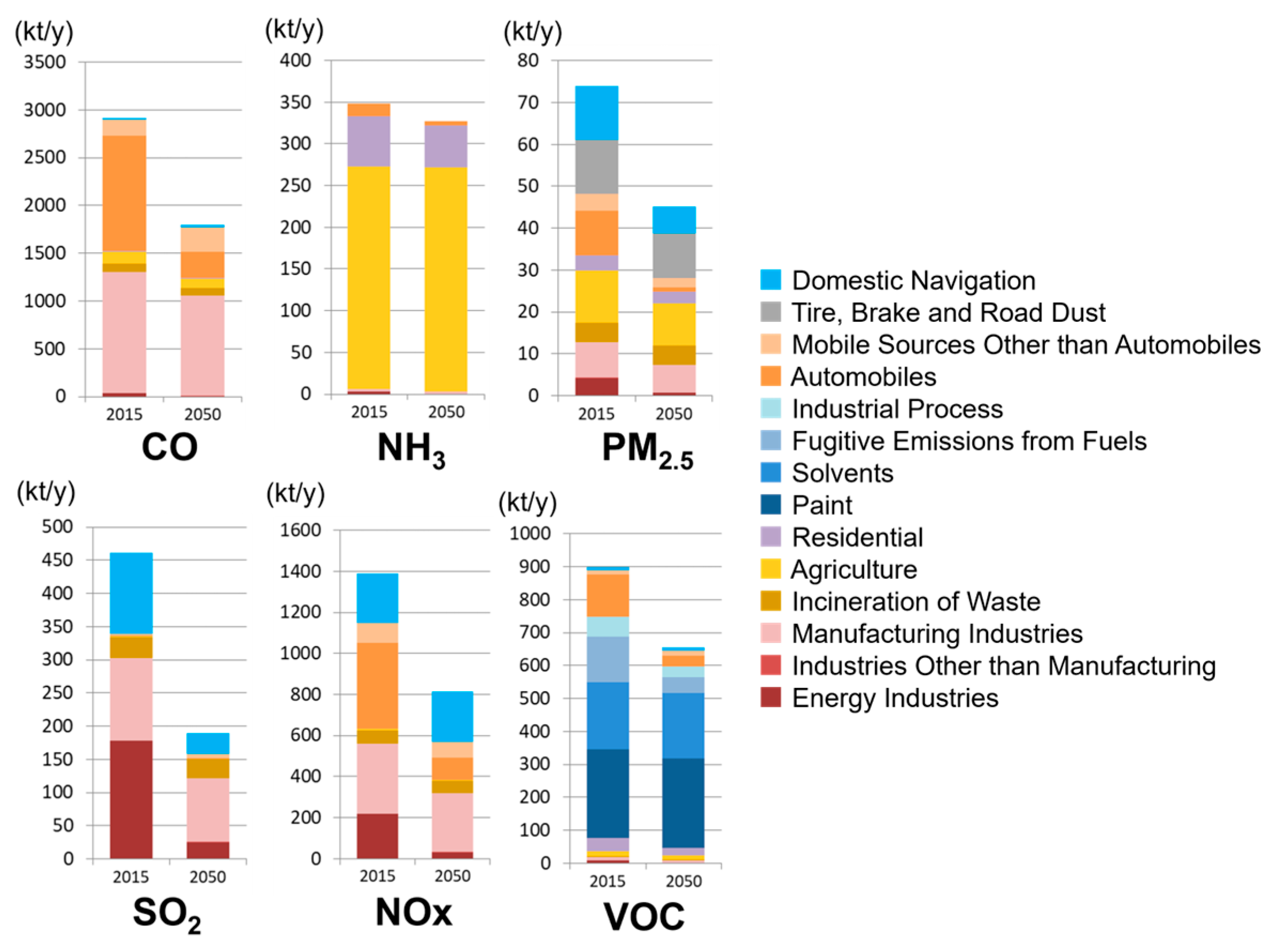

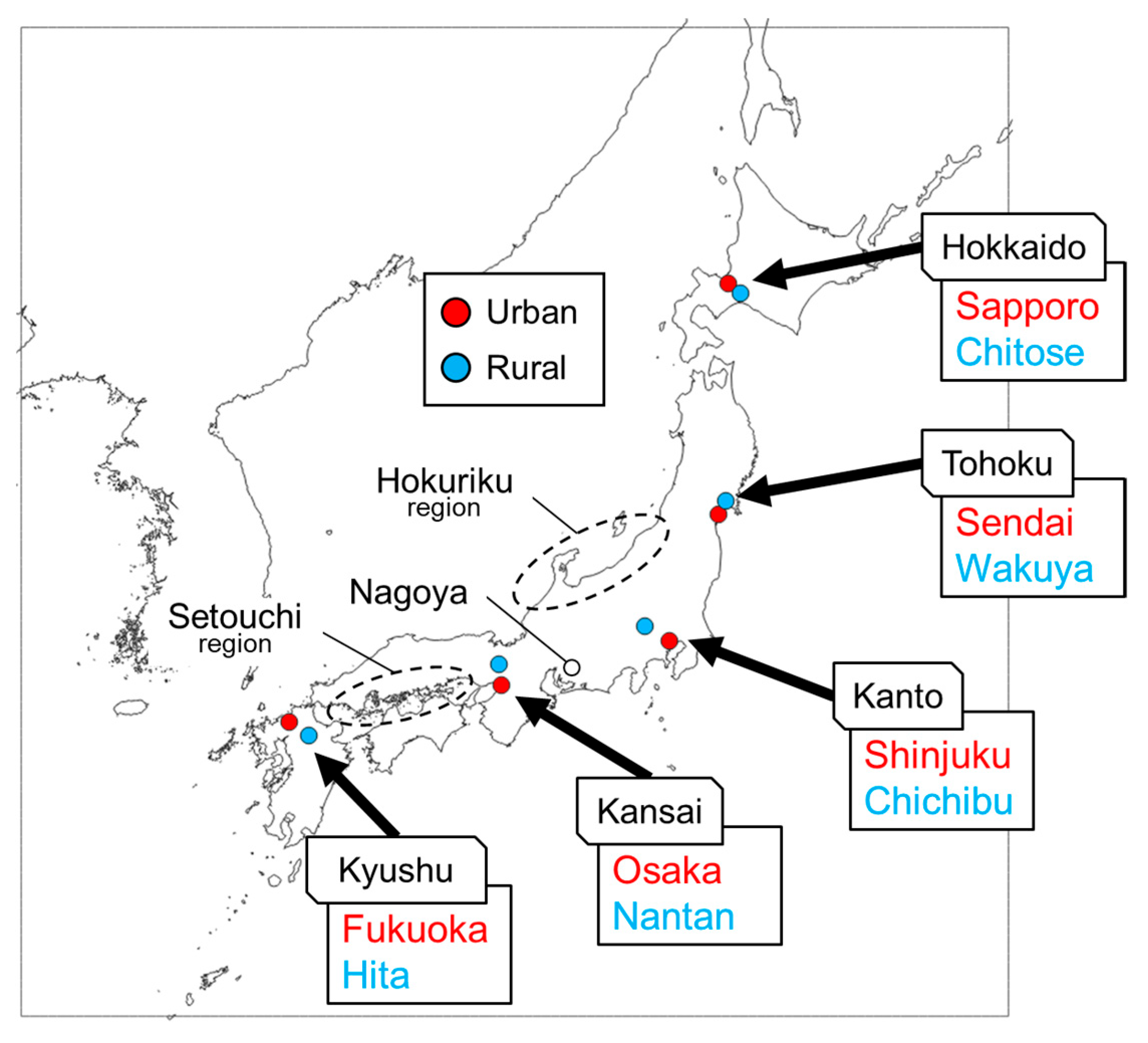
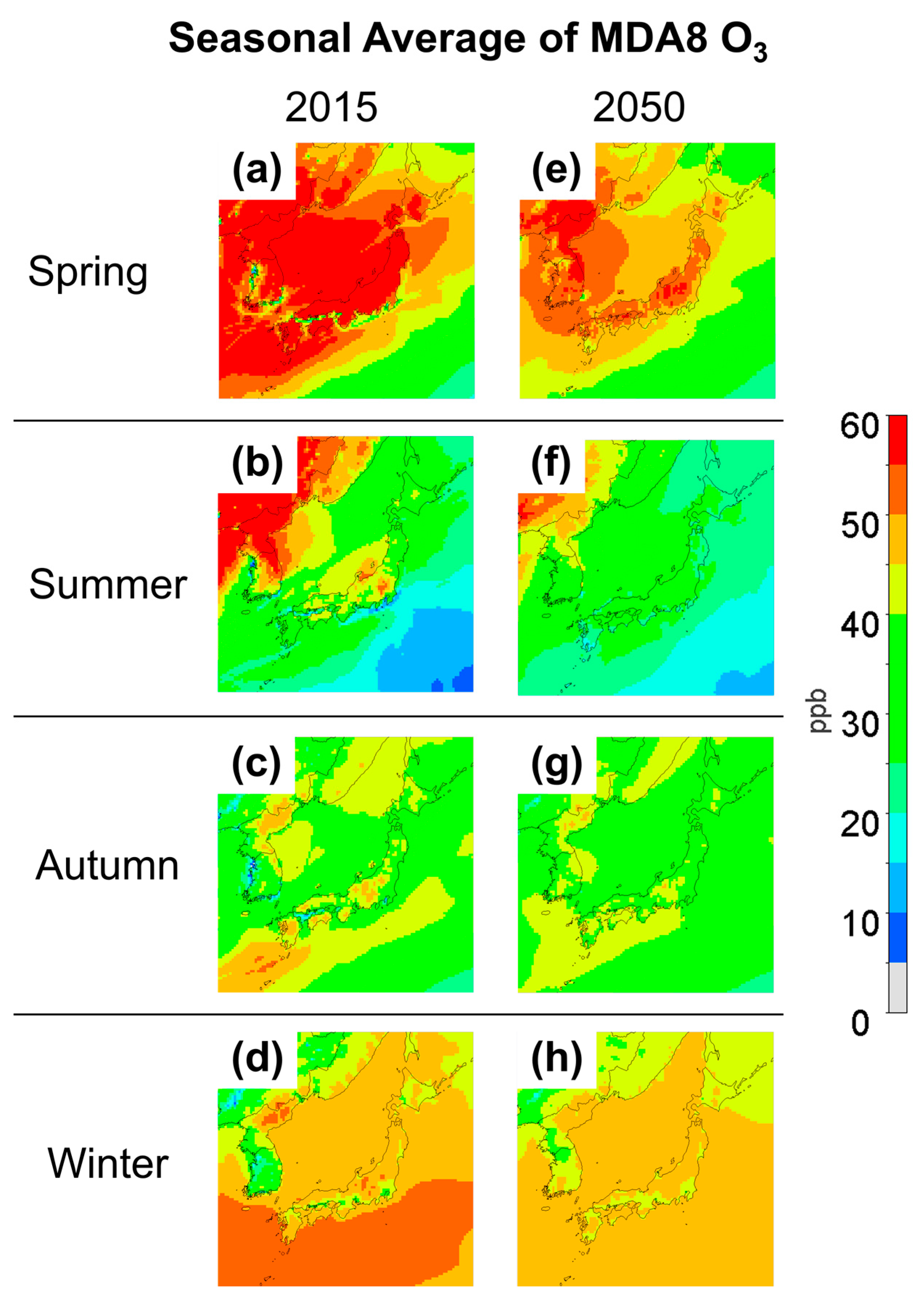
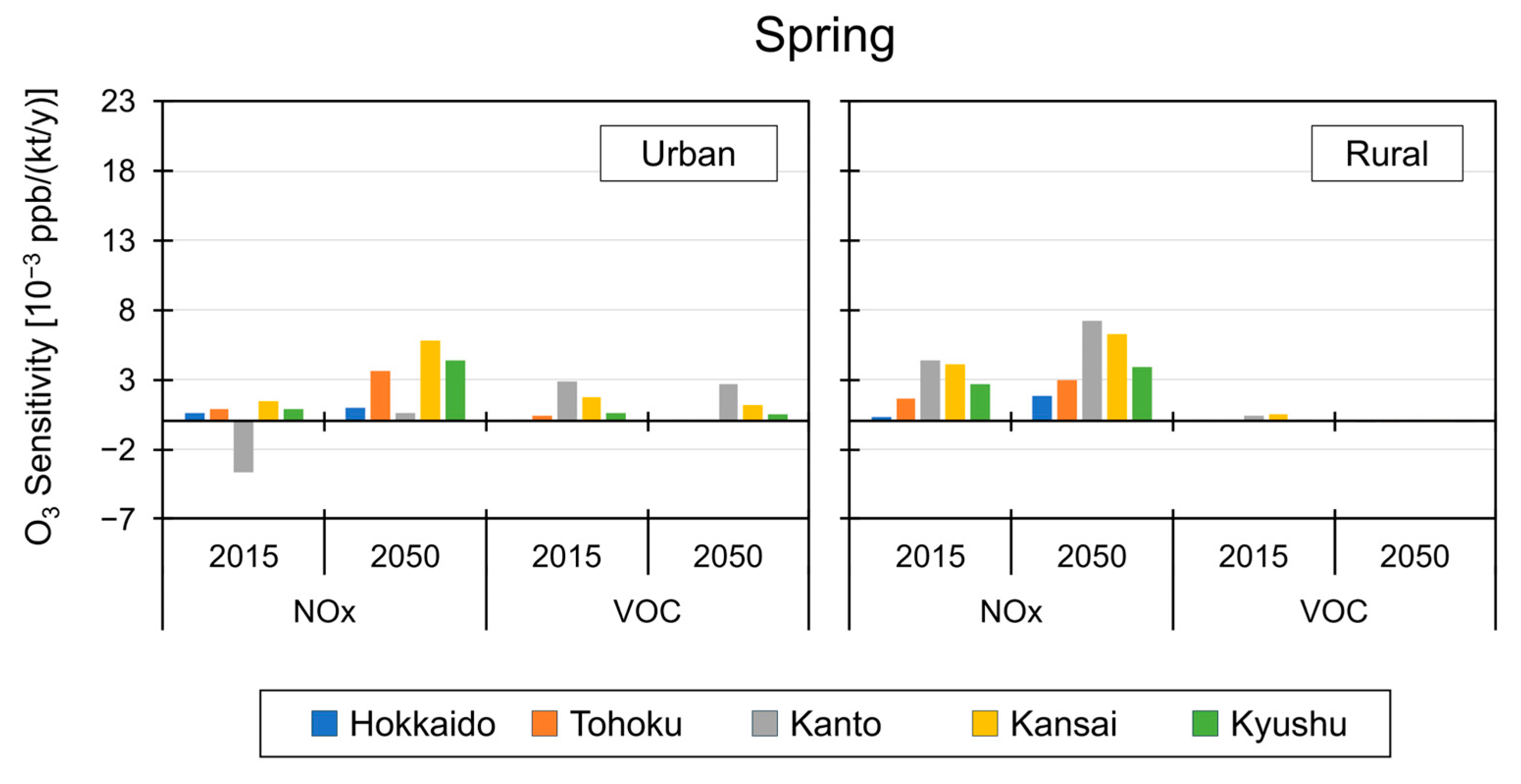
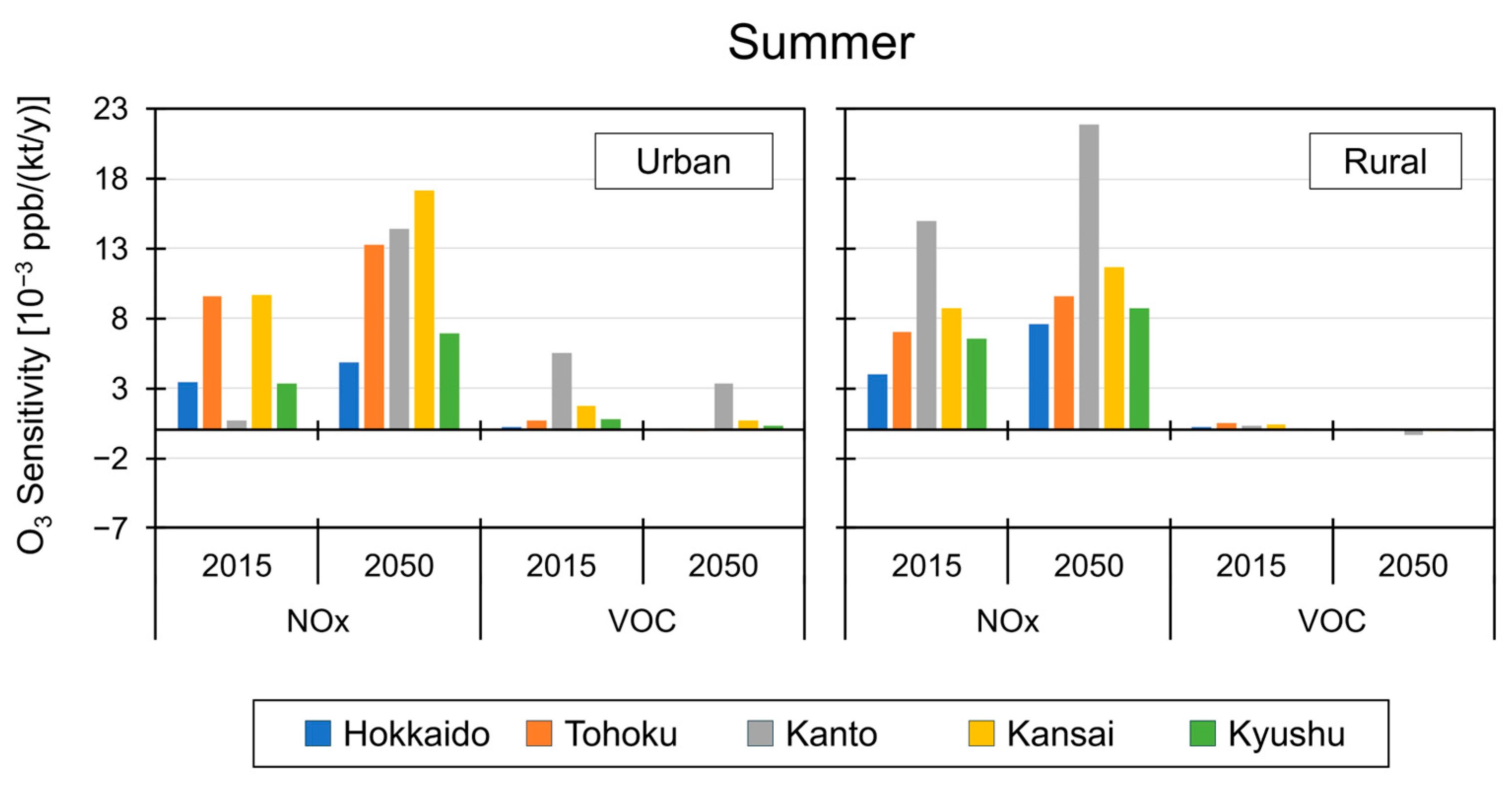
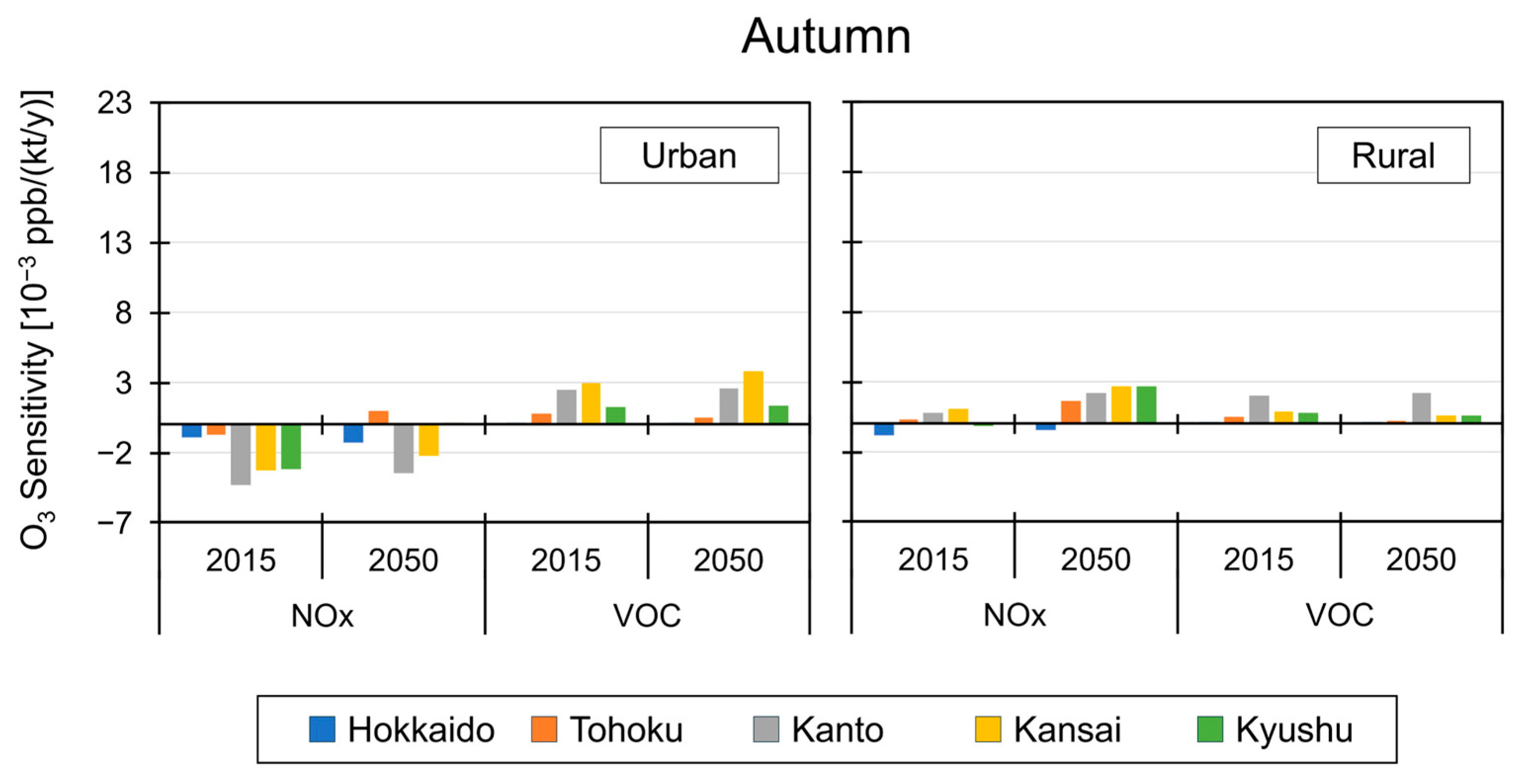



| Scenario | East Asia | Japan | ||
|---|---|---|---|---|
| Year | Year | Anthropogenic NOx Emissions | Anthropogenic VOC Emissions | |
| 2015 Base | 2015 | 2015 | ±0% | ±0% |
| 2015 NOx +10% | +10% | ±0% | ||
| 2015 NOx +20% | +20% | ±0% | ||
| 2015 NOx −10% | −10% | ±0% | ||
| 2015 NOx −20% | −20% | ±0% | ||
| 2015 VOC +10% | ±0% | +10% | ||
| 2015 VOC +20% | ±0% | +20% | ||
| 2015 VOC −10% | ±0% | −10% | ||
| 2015 VOC −20% | ±0% | −20% | ||
| 2050 Base | 2050 | 2050 | ±0% | ±0% |
| 2050 NOx +10% | +10% | ±0% | ||
| 2050 NOx +20% | +20% | ±0% | ||
| 2050 NOx −10% | −10% | ±0% | ||
| 2050 NOx −20% | −20% | ±0% | ||
| 2050 VOC +10% | ±0% | +10% | ||
| 2050 VOC +20% | ±0% | +20% | ||
| 2050 VOC −10% | ±0% | −10% | ||
| 2050 VOC −20% | ±0% | −20% | ||
| Season | MBE (ppb) | RMSE (ppb) | IoA | ||||||
|---|---|---|---|---|---|---|---|---|---|
| Ave. | Max. | Min. | Ave. | Max. | Min. | Ave. | Max. | Min. | |
| Spring | 8.1 | 14.0 | −2.3 | 12.5 | 17.9 | 8.0 | 0.32 | 0.65 | −0.24 |
| Summer | 8.9 | 16.1 | −1.6 | 14.9 | 18.5 | 9.8 | 0.44 | 0.84 | −0.27 |
| Autumn | 10.0 | 14.9 | 8.0 | 12.0 | 17.1 | 9.4 | 0.26 | 0.51 | −0.15 |
| Winter | 15.6 | 18.1 | 12.3 | 16.7 | 20.2 | 13.0 | −0.39 | 0.04 | −0.83 |
Disclaimer/Publisher’s Note: The statements, opinions and data contained in all publications are solely those of the individual author(s) and contributor(s) and not of MDPI and/or the editor(s). MDPI and/or the editor(s) disclaim responsibility for any injury to people or property resulting from any ideas, methods, instructions or products referred to in the content. |
© 2025 by the authors. Licensee MDPI, Basel, Switzerland. This article is an open access article distributed under the terms and conditions of the Creative Commons Attribution (CC BY) license (https://creativecommons.org/licenses/by/4.0/).
Share and Cite
Yamadaya, Y.; Hayashi, R.; Ueda, T.; Morikawa, T.; Hayasaki, M.; Yamada, H.; Tanaka, K.; Okayama, S.; Shibata, Y.; Watanabe, H.; et al. Sensitivity Analysis of Tropospheric Ozone Concentration to Domestic Anthropogenic Emission of Nitrogen Oxides (NOx) and Volatile Organic Compounds (VOC) in Japan: Comparison Between 2015 and 2050. Atmosphere 2025, 16, 1261. https://doi.org/10.3390/atmos16111261
Yamadaya Y, Hayashi R, Ueda T, Morikawa T, Hayasaki M, Yamada H, Tanaka K, Okayama S, Shibata Y, Watanabe H, et al. Sensitivity Analysis of Tropospheric Ozone Concentration to Domestic Anthropogenic Emission of Nitrogen Oxides (NOx) and Volatile Organic Compounds (VOC) in Japan: Comparison Between 2015 and 2050. Atmosphere. 2025; 16(11):1261. https://doi.org/10.3390/atmos16111261
Chicago/Turabian StyleYamadaya, Yoshiaki, Ran Hayashi, Tomoya Ueda, Tazuko Morikawa, Masamitsu Hayasaki, Hiroyuki Yamada, Kotaro Tanaka, Shinichiro Okayama, Yoshiaki Shibata, Hiroe Watanabe, and et al. 2025. "Sensitivity Analysis of Tropospheric Ozone Concentration to Domestic Anthropogenic Emission of Nitrogen Oxides (NOx) and Volatile Organic Compounds (VOC) in Japan: Comparison Between 2015 and 2050" Atmosphere 16, no. 11: 1261. https://doi.org/10.3390/atmos16111261
APA StyleYamadaya, Y., Hayashi, R., Ueda, T., Morikawa, T., Hayasaki, M., Yamada, H., Tanaka, K., Okayama, S., Shibata, Y., Watanabe, H., & Kidokoro, T. (2025). Sensitivity Analysis of Tropospheric Ozone Concentration to Domestic Anthropogenic Emission of Nitrogen Oxides (NOx) and Volatile Organic Compounds (VOC) in Japan: Comparison Between 2015 and 2050. Atmosphere, 16(11), 1261. https://doi.org/10.3390/atmos16111261






